BLUEBERRIES AND ASPARAGUS (SEPARATELY)
All Good
I’ve never met a blueberry I didn’t like. Then again, I have yet to taste a rabbiteye blueberry (Vaccinium asheii), native to southeastern U.S. and highly acclaimed there. I also have yet to taste Cascades blueberry (V. deliciosum), native to the Pacific northwest. With “deliciosum” as its species name, how could it not taste great? And those are just two of the many species of blueberry that I’ve never tasted that are found throughout the world.
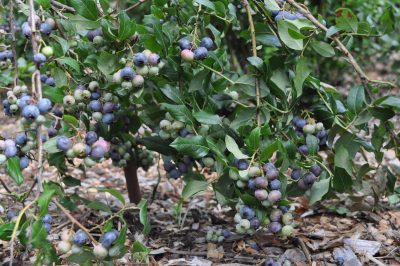 The blueberries with which I am most familiar are those that I grow, which are highbush blueberry and lowbush blueberry. I grow blueberries because they are beautiful plants, because they are relatively pest free, because they are delicious, and because they fruit reliably for me year after year.
The blueberries with which I am most familiar are those that I grow, which are highbush blueberry and lowbush blueberry. I grow blueberries because they are beautiful plants, because they are relatively pest free, because they are delicious, and because they fruit reliably for me year after year.
I have to admit that highbush blueberries, at least to me, all taste pretty much the same. They have nowhere the broad flavor spectrum of apples. Tasting the same is fine with me; as I wrote, they are delicious. Depending on the variety, the berries do vary in ripening season, size, and other less obvious characteristics. One very important influence on flavor is how they are picked. Blueberries turn blue a few days before they are at their peak flavor, which is okay if you’re marketing them and just want them blue. But the best tasting tasting, dead-ripe ones are those that drop into your hand as you tickle a bunch of berries, which makes a good case for growing them near your back door.
Lowbush blueberries also taste pretty much the same from plant to plant, but their flavor is decidedly different from that of highbush blueberries, a more metallic sweetness. Few varieties of lowbush blueberry exist, so most plants are just random seedlings anyway. Not to disparage that, though; they’re also all delicious — if picked at the right moment.
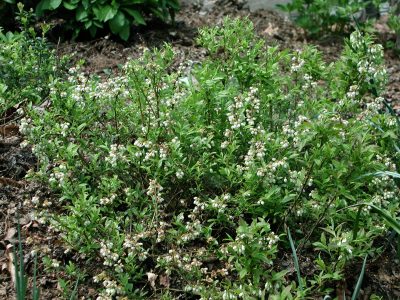
A Different Blueberry
My idea that all highbush blueberries taste pretty much the same was recently challenged. New highbush varieties have been bred or selected since this native fruit went, over the past 100 years, from being harvested from mostly from the wild to being mostly cultivated. Over the years I’ve been very pleased with the nine varieties I had been growing, spreading out the harvest season from late June until early September.
Then the new variety, Nocturne, bred by Dr. Mark Ehlenfeldt of the USDA, caught my eye. Besides being billed as having unique flavor, Nocturne was also said to be notable for its jet-black fruits which, before they turn jet black, are vivid red-orange in color. What attracted me wasn’t the fruit’s unique colors, but its allegedly unique flavor atypical, so the description read, of either rabbiteye [which is in Nocturne’s lineage] or highbush.”

So I called Mark to learn more about the variety. One of the original breeding goals back 25 years ago, when Nocturne’s carefully selected parents were mated, was to get a rabbiteye variety that, blooming later than most, would be less susceptible to spring frosts. Chemically, two significant differences between rabbiteye and highbush blueberries are their organic acids. Rabbiteyes have mostly malic and succinic acids, yielding a flatter taste profile than highbush fruits, whose citric acid makes for a brighter, sharper flavor. Other species were also thrown into the mix, including Constable’s blueberry (V. constablaei), a native of higher elevations in southeastern U.S., and contributing late blooming and excellent flavor.
Long story short: Nocturne is significant for being a variety with significant rabbiteye parentage that is winter hardy to well below zero degrees Fahrenheit and late blooming. It has excellent flavor, juicy sweet, and sprightly, and quite different from my other highbush varieties. Nocturne tastes even juicier than it is. Which do I like better? Neither, I like them all. Nocturne, now in its third year here on the farmden, now has a permanent place in my Blueberry Temple.
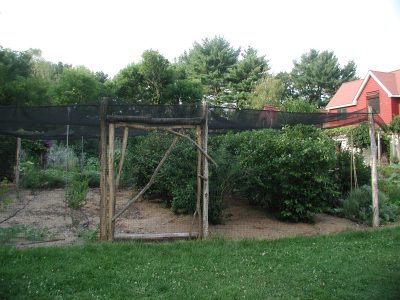
Blueberry Temple
Learn the Ins and Outs of Growing Blueberries
If you have the space, grow blueberries. To that end, I will be holding a zoom workshop/webinar on growing blueberries on August 12, 2020 from 7-8:30 pm EST. I’ll cover everything from planting right through harvest and preservation. If you’re new to growing blueberries, you’ll learn how to grow this fruit successfully. If you already grow blueberries, you’ll be able to grow them better. If you’re an expert on growing blueberries, you don’t need this workshop/webinar. Registration ($35) is a must as space is limited; registration link is
https://us02web.zoom.us/webinar/register/WN_NSTrunuTRkOcRfS-frQuYg. For more information, go to https://leereich.com/workshops.
Asparagus Redux
On a totally different topic, I’d like to followup on my end-of-harvest-season treatment of asparagus. Weeds have always been somewhat problematic in my asparagus bed. Harvest ceases at the end of June so plants can grow freely and feed energy to the roots which will fuel the following year’s spears in spring. Weeds quickly move into this hard-to-weed area.
As I wrote on this blog a few weeks ago, this past June, at the end of asparagus harvest season, I mowed everything, weeds as well as emerging asparagus spears, to the ground with my scythe. I then blanketed the ground with a thick mulch. I first laid down an inch depth of compost, which will feed the soil as well as smother roots, and then topped that with another inch or two of wood chips.
There was the danger of smothering the emergence of new asparagus shoots, but plenty have pushed up through the mulch.
As far as weeds, there are very few. Most of them appear at the grassy edge of the bed.
Success!
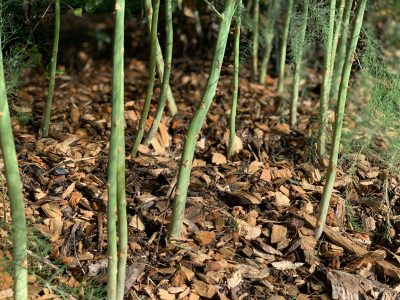


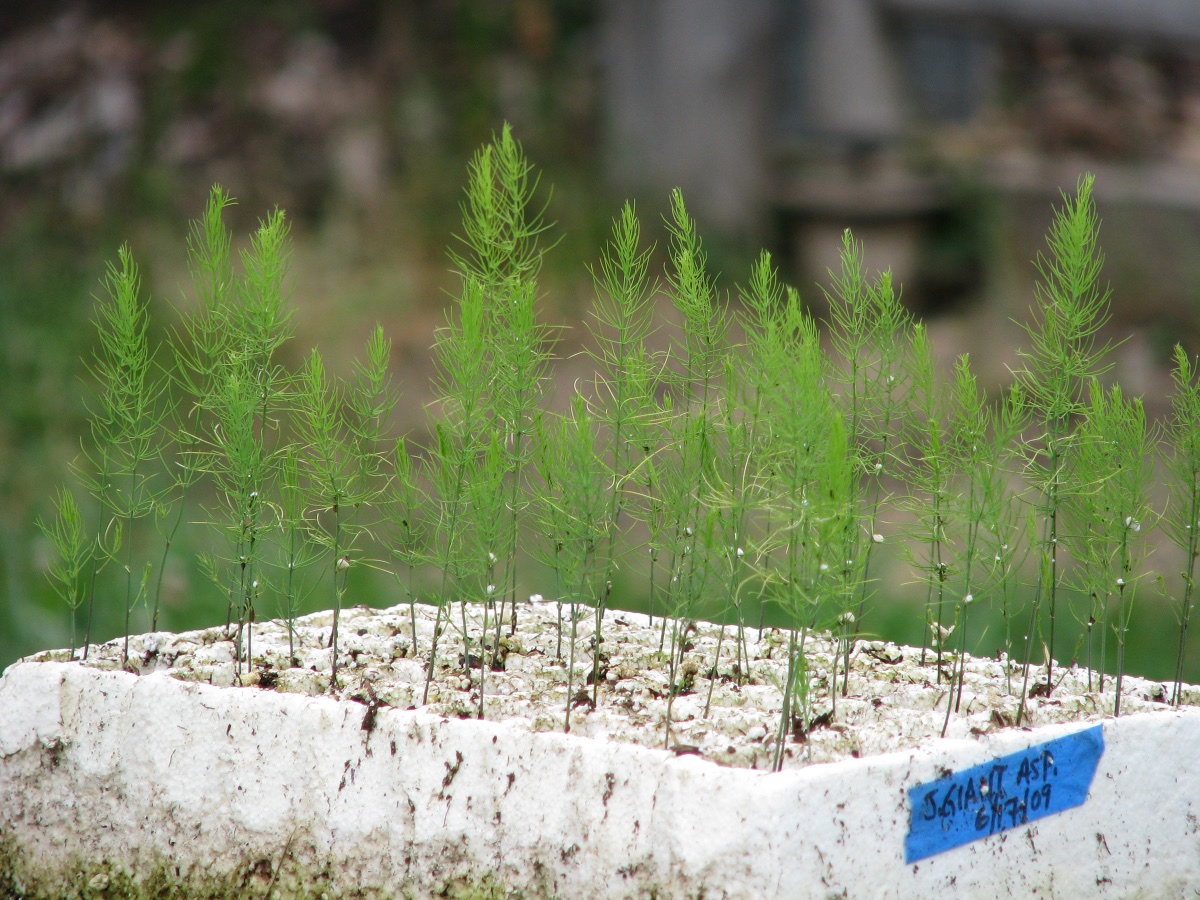

Shortly after buying my farm in the Western Finger Lakes of New York 18 years ago an older guy (like I am now) stopped by. He told me that he was born on this farm and had all sorts of photos to share.
After chatting for a bit he asked us how we like the blueberries he planted behind the pond (about half a mile away). We had never been to that area of our land but after he left I immediately mowed a path through 5 foot high vegetation to find 7 high bush blueberries that we’re about 7 feet tall.
I proceeded to remove dead wood and waited until August when we found an amazing amount of delicious blueberries. We’ve been enjoying them and sharing them with the bees and occasional bear ever since.
I only mow around and trim the bushes yet get bountiful crops every year.
That was 18 years ago! I thought you moved just a few years ago. Good story about the blueberries. How about birds?
I moved 18 years ago from the new Paltz area although it doesn’t feel like it. Birds also enjoy them but they get the ones I can’t reach anyway.
Hi Lee: I am a little out of sequence but just read your July 29 post on microwaving garden soil. How do you know you aren’t getting it too hot? Are you picking a temperature on the microwave or somehow monitoring the temp as it cooks?
Kari, Minnesota
(I wish you had said you used it to control damping off!)
I monitor it periodically by stopping in and taking its temperature with a thermometer. Then I know settings needed for the future.
Damping off can also be kept in check with good air circulation and light, and well-drained soil. Watering with chamomile tea allegedly also helps.
\
I’ve tasted rabbiteye berries at a friend’s place in Alabama: he grows mostly highbush but a few rabbiteye. The rabbiteye are not nearly as flavorful, you are right saying they are much flatter.
I just moved from OR to South Carolina; everyone grows rabbiteye here, but I bought a couple of highbush for my garden (Sweetheart, & it was so expensive they gave a Legacy as a free gift. I hope to have some berries next year if the birds don’t get them. I’ll try to take your seminar but I think my computer’s going to the shop on Monday so probably won’t be able to do it.
I also got a little fig tree: LSU purple which is designed for the South & bears twice a year. I’ve planted the fig & the berries near each other so hope it will be easier to make a cage or something to keep birds off.
Thanks for your articles.
Billye Timbes
I just planted a LSU Purple (in a pot). Problem is that LSU Purple has often been mislabeled, with other varieties also sold under that name. I’m trying to catagorize my fig varieties by their leaf shapes.
Oh, dear how will I know if this is the right fig–do I have to wait till it does or doesn’t produce?
I had not heard of this LSU fig till I moved here (SC) last winter. I had an Italian fig whose name I can never remember (starts with L) & a Texas Everbearing. Both did very well but of course the Tex was my favorite because it produced in the fall as well as spring. This LSU is supposed to do that too, at least down here in the south.
It’s a long way from Portland, I could grow anything there, here the hot sun has damaged a lot of plants–I had to have a tree trimmed & now the shade is gone. Almost lost an oakleaf hyd.but I think I moved it in time. Sun is fierce.
You don’t have too much of my sympathy. 🙂 Up here, the cold kills all but the hardiest plants. And this summer has been hot and humid like a South Carolinan summer (except shorter, no doubt).
Lee:
You mentioned that you have a New blueberry variety called Nocturne.
How did you fit it into your Farm Den?
Did you remove a bush or extend the Den size?
What are the 9 varieties you previously mentioned ?
I misplaced my notes on the as I follow you with your fine blogs.
Happy Gardening
Ken
I remove a bush, Bluegold, which wasn’t that good for us, for Nocturne. It went to the front of the little cottage that we rent out next door. Other blueberries here are Nelson, Jersey, Duke, Toro, Elliot, Bluecrop, Blueray, and Berkely. (We have more than one of some of them. Nelson may go also.
Lee:
Have you tried REKA blueberry bush (New Zealand )?
I recently did away with Chandler. Beautiful size berry but very prone to insects.
In your BB Farm Den you mean to say you have a chicken size wire all the way to the ground. Isn’t that more expensive than netting?
Great Blogs with your garden. Keep up the god work.
Regards,
Ken F..
No, chicken wire is about 18″ high and just outside the plastic netting.
Lee,
You plant your new bush in the same spot as the removed bush? If so, there is no worry about replant disease? I’ve read that can be a problem with apple trees.
Richard
There’s no replant disease of blueberries that I know of. Compared to apples, blueberries have very few disease problems anyway — one of their many qualities.
Hi, I wanted to let you know I found your article about blueberries and asparagus very helpful. Thank you, Richard
Greetings,
Thank you very much for sharing your gardening knowledge….so helpful!
I live in northern California and have more luck growing blueberries in containers than in the ground. I have a chance to purchase a few older high bush blueberries plants from a local blueberry farm and was wondering if you could tell me if they would do well in a raised bed environment ( where I live is the gopher capitol of the world ). If yes, how deep should the soil be and since we will be filling the beds from scratch what would be the best mix for the blueberries?
TIA, Susan
Blueberries do fine in raised beds as long as water is also available and the soil is well aerated, high in organic matter, and very acidic. Raised high enough so the roots, the majority of which run only about 6 inches deep, are above a permanent water table is adequate if drainage is poor. Dig in plenty of peat moss.
Hi again,
I will be filling the beds with a yard of soil what percentage of peat moss would you recommend?
I just add a bucketful (very inexact measure) to each planting hole.
I’ve had Reka here in Kentucky for over a decade. It’s an early highbush variety, with
a very distinct taste. One university test found it was the most disliked field tested berry during public tours, with a little over 30% not liking it. It is distinctly tart, and while my kids like it quite a bit, they would rather eat the Duke and Earliblue (which is just an OK taste) and have me make muffins with Reka. They are the best cooking blueberries we have, and the muffins made with the vanish even more quickly than normal. Think of Granny Smith apples, except for blueberries. They are on the small side compared to the more recent cultivars, but were probably average sized when they were developed.
I would consider Reka as having a normal growth habbit, except it sends up new shoots more readily than the other ones I have. Elliot and Duke are close behind it. It is the most tolerant highbush blueberry I have for drainage and soil quality. It survived the die off of close to half my blueberries, once my peat moss and compost amendment largely decayed, leaving too much clay. Plus, and I didn’t know it at the time, we have very hard water, at 79 ppm, and once the buffering was gone along with the organic matter, the blueberries were decidedly unhappy. Switching to rain water, pelletized sulfer twice a year, and heavy side dressing of organic matter saved about half my original plants, which are now over a decade old. I am experimenting with Southern High Bush and Rabbiteye’s, and hope to have some Nocturne berries to harvest in another year. Your initial review helped me decide to get it – thanks!
BTW All of our 40 plus plants are covered with frost covers AGAIN, for the second time this year. Kentucky is notorious for late freezes, and I’m talking a second hard frost and snow – 31F – that would have wiped out about half the highbush blueberry blossoms (Duke, Reka, some of the Bluecrop and Legacy), and all the southern and rabbiteye ones. My one year old Nocturnes have some isolated flower buds that are just short of opening,
BTW getting Legacy as a freebie is a GREAT deal. They aren’t quite as soil tolerant as Reka, but that still puts them pretty high in the pack (Elliot is another phenomenally soil tolerant cultivar). Legacy is a great pollinator, and has what I would call a good, solid blueberry taste. They are considered a Southern Highbush variety, but like Nocturne they have very high chilling hours. Plus they are a multi-species hybrid and have a long blooming period, so they hopefully can pollinate all three types. They were developed by the University of Arkansas, so the climate zone is very similar to New Jersey, and a little milder than here in north central Kentucky. They also tolerate our hot summers well.
Thanks, Shawn, for all that good information. Many years ago I worked at the USDA Fruit Laboratory in Beltsville, MD and, if I remember correctly, the breeders there were also looking for greater soil adaptability in blueberry.
I am having difficulty finding Duke, Chandler, and Draper blueberry bushes that are 3-4′ tall in 3 gallon containers. Do you know of a reliable source that will sell and ship 2 each of these varieties so I can get them planted this fall? I reside in Ohio.
Thanks, Fred Mankins
740-398-9809
Hartmann’s Nursery sells potted plants, but I don’t think that large. Check them out. They’re in Michigan.
I appreciate your recommendation. I went there (5 hour drive) and was very pleasantly surprised with the quality and size of the bushes. They were awesome. A great group of people to business with and I got the opportunity to meet Mr. Hartman, the owner.